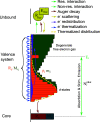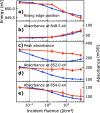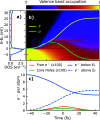Electron population dynamics in resonant non-linear x-ray absorption in nickel at a free-electron laser
- PMID: 37841290
- PMCID: PMC10576398
- DOI: 10.1063/4.0000206
Electron population dynamics in resonant non-linear x-ray absorption in nickel at a free-electron laser
Abstract
Free-electron lasers provide bright, ultrashort, and monochromatic x-ray pulses, enabling novel spectroscopic measurements not only with femtosecond temporal resolution: The high fluence of their x-ray pulses can also easily enter the regime of the non-linear x-ray-matter interaction. Entering this regime necessitates a rigorous analysis and reliable prediction of the relevant non-linear processes for future experiment designs. Here, we show non-linear changes in the -edge absorption of metallic nickel thin films, measured with fluences up to 60 J/cm2. We present a simple but predictive rate model that quantitatively describes spectral changes based on the evolution of electronic populations within the pulse duration. Despite its simplicity, the model reaches good agreement with experimental results over more than three orders of magnitude in fluence, while providing a straightforward understanding of the interplay of physical processes driving the non-linear changes. Our findings provide important insights for the design and evaluation of future high-fluence free-electron laser experiments and contribute to the understanding of non-linear electron dynamics in x-ray absorption processes in solids at the femtosecond timescale.
© 2023 Author(s).
Conflict of interest statement
The authors have no conflicts to disclose.
Figures













Similar articles
-
Ablation of porcine ligamentum flavum with Ho:YAG, q-switched Ho:YAG, and quadrupled Nd:YAG lasers.Lasers Surg Med. 2015 Dec;47(10):839-51. doi: 10.1002/lsm.22424. Epub 2015 Sep 28. Lasers Surg Med. 2015. PMID: 26415136 Free PMC article.
-
The TRIXS end-station for femtosecond time-resolved resonant inelastic x-ray scattering experiments at the soft x-ray free-electron laser FLASH.Struct Dyn. 2020 Sep 16;7(5):054301. doi: 10.1063/4.0000029. eCollection 2020 Sep. Struct Dyn. 2020. PMID: 32953941 Free PMC article.
-
Ultrafast X-ray Transient Absorption Spectroscopy of Gas-Phase Photochemical Reactions: A New Universal Probe of Photoinduced Molecular Dynamics.Acc Chem Res. 2018 Dec 18;51(12):3203-3211. doi: 10.1021/acs.accounts.8b00462. Epub 2018 Nov 21. Acc Chem Res. 2018. PMID: 30462481
-
Unveiling and driving hidden resonances with high-fluence, high-intensity x-ray pulses.Phys Rev Lett. 2011 Dec 2;107(23):233001. doi: 10.1103/PhysRevLett.107.233001. Epub 2011 Nov 30. Phys Rev Lett. 2011. PMID: 22182083
-
Femtosecond soft X-ray absorption spectroscopy of warm dense matter at the PAL-XFEL.J Synchrotron Radiat. 2020 Jul 1;27(Pt 4):953-958. doi: 10.1107/S160057752000524X. Epub 2020 May 19. J Synchrotron Radiat. 2020. PMID: 33566003
Cited by
-
Simultaneous mapping of the ultrafast time and fluence dependence of the laser-induced insulator-to-metal transition in magnetite.Struct Dyn. 2025 Mar 20;12(2):024302. doi: 10.1063/4.0000288. eCollection 2025 Mar. Struct Dyn. 2025. PMID: 40124102 Free PMC article.
-
Preface to Special Topic: The Advent of Ultrafast X-Ray Absorption Spectroscopy.Struct Dyn. 2024 Jun 21;11(3):030401. doi: 10.1063/4.0000259. eCollection 2024 May. Struct Dyn. 2024. PMID: 38912290 Free PMC article. No abstract available.
References
-
- Rossbach J., Schneider J. R., and Wurth W., “ 10 years of pioneering x-ray science at the free-electron laser FLASH at DESY,” Phys. Rep. 808, 1–74 (2019). 10.1016/j.physrep.2019.02.002 - DOI
-
- Bostedt C., Boutet S., Fritz D. M., Huang Z., Lee H. J., Lemke H. T., Robert A., Schlotter W. F., Turner J. J., and Williams G. J., “ Linac coherent light source: The first five years,” Rev. Mod. Phys. 88, 015007 (2016). 10.1103/RevModPhys.88.015007 - DOI
-
- Nagler B., Zastrau U., Fäustlin R. R., Vinko S. M., Whitcher T., Nelson A. J., Sobierajski R., Krzywinski J., Chalupsky J., Abreu E., Bajt S., Bornath T., Burian T., Chapman H., Cihelka J., Döppner T., Düsterer S., Dzelzainis T., Fajardo M., Förster E., Fortmann C., Galtier E., Glenzer S. H., Göde S., Gregori G., Hajkova V., Heimann P., Juha L., Jurek M., Khattak F. Y., Khorsand A. R., Klinger D., Kozlova M., Laarmann T., Lee H. J., Lee R. W., Meiwes-Broer K.-H., Mercere P., Murphy W. J., Przystawik A., Redmer R., Reinholz H., Riley D., Röpke G., Rosmej F., Saksl K., Schott R., Thiele R., Tiggesbäumker J., Toleikis S., Tschentscher T., Uschmann I., Vollmer H. J., and Wark J. S., “ Turning solid aluminium transparent by intense soft x-ray photoionization,” Nat. Phys. 5, 693–696 (2009). 10.1038/nphys1341 - DOI
-
- Recoules V. and Mazevet S., “ Temperature and density dependence of XANES spectra in warm dense aluminum plasmas,” Phys. Rev. B 80, 064110 (2009). 10.1103/PhysRevB.80.064110 - DOI
-
- Di Cicco A., Hatada K., Giangrisostomi E., Gunnella R., Bencivenga F., Principi E., Masciovecchio C., and Filipponi A., “ Interplay of electron heating and saturable absorption in ultrafast extreme ultraviolet transmission of condensed matter,” Phys. Rev. B 90, 220303(R) (2014). 10.1103/PhysRevB.90.220303 - DOI
LinkOut - more resources
Full Text Sources

